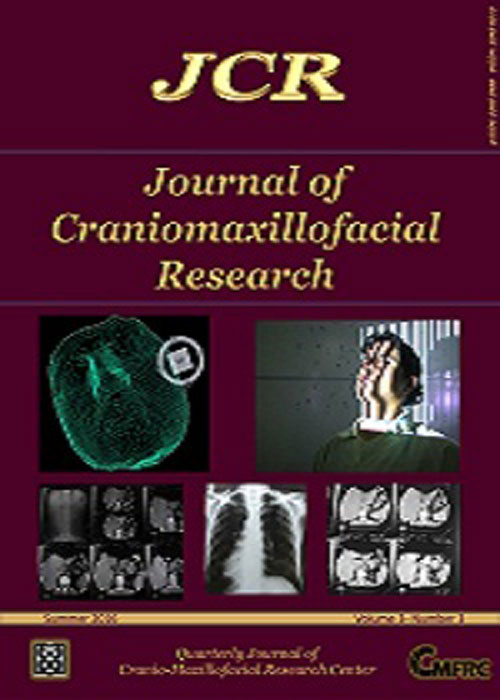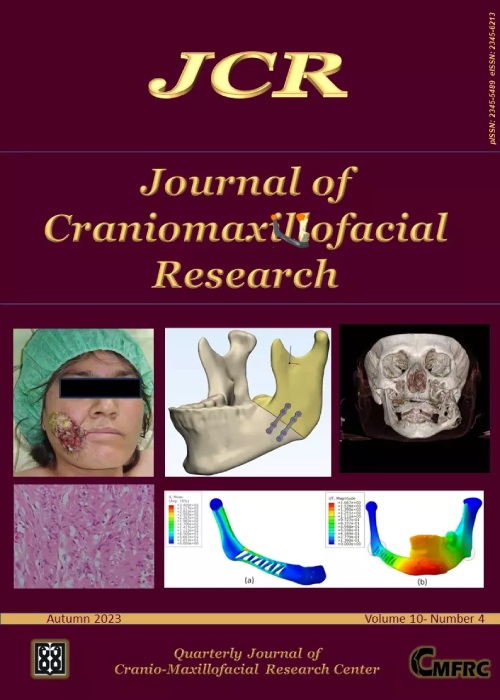فهرست مطالب

Journal of Craniomaxillofacial Research
Volume:2 Issue: 3, Summer-Autumn 2015
- تاریخ انتشار: 1394/11/03
- تعداد عناوین: 8
-
-
Pages 112-115IntroductionSaliva as a simple non-invasive method of gaining body fluids has been used to detect the thyroid hormones. A single method for determining these hormones has not been clearly stated in the literature. Furthermore, thyroid diseases would affect the salivary glands and may compromise salivary flow.Materials And MethodsA comprehensive search was conducted using PubMed and Medline.ConclusionSaliva can successfully be used as a non-invasive method for determining thyroid hormones and for detecting and monitoring thyroid dysfunctions. Thyroid dysfunctions also have a great impact on salivary gland functions and saliva.Keywords: Saliva, Salivary Glands, Thyroid Disease
-
Pages 116-121IntroductionThis study was conducted to investigate the side effects of closed reduction method as a treatment modality of unilateral condylar fractures of the mandible in patients referred to Shahid Beheshti University Hospital (Babol, Iran) over than one decade (2002 to 2012).Materials And MethodsTo accomplish this study, patients data were collected referring to their files in Shahid Beheshti University Hospital. Cases with unilateral condylar fractures of the mandible aged older than 12 who treated by closed reduction technique; were selected. Finally, 24 out of 78 selected patients entered to this study. Considering the variants such as age, gender, maximum mouth opening (MMO), mandibular deviation from midline on MMO and patients satisfaction of mastication were captured.ResultAbout 24 patients, 18 males (75%) and 6 females (25%) aged from 13 to 52 and the mean age of 24.7, were included in this study. The MMO of 23 cases (95.83%) were in normal range (7 35 mm); 23 patients (95.83%) were satisfied with their quality of mastication. 17 cases (70.83%) out of all patients had no deviation during mouth opening.ConclusionAccording to low complication rate of closed reduction of mandibular condylar fractures deduced in this study, it may be acceptable as a conservative treatment modality.Keywords: Closed Reduction Technique, Complications, Mandibular Condylar Fractures
-
Pages 122-127IntroductionFractures of the orbital floor, which are caused by various mechanisms, result in the herniation of periorbital tissue into the paranasal sinuses and its subsequent complications. Early diagnosis using various techniques and reduction of fractures are necessary to preserve ocular function and esthetic. Use of an endoscope has been associated with some advantages, including a decrease in the number of external incisions and soft tissue manipulations. The aim of the present study was to evaluate complications of reducing fractures of the orbital floor and the infra-orbital rim with the use of an endoscope and conventional techniques.Materials And MethodsA total of 40 patients with fractures of the orbital floor were included in this clinical trial. The subjects were equally divided into two groups (n = 20). In Group 1, the complications of treatment with an endoscopic view were evaluated in addition to comparison of the sensitivity of endoscope and 3-mm computed tomography (CT) slices with the gold standard. In Group 2, complications of treatment with the conventional technique were compared with those in Group 1. T-test, chi-squared and Fishers exact tests, ANOVA and Tukey test for multiple comparisons were used for statistical analyses with SPSS statistical software.ResultThere were no statistically significant differences between the two groups regarding age and gender. The sensitivity of the endoscope-assisted surgery in comparison to the gold standard was estimated to be 70% with a sensitivity of 85% in comparison to 3-mm CT scan slices. There was a significant difference between the two groups regarding complications, including edema, lower eyelid scars (P = 0.024), indicating superiority of the endoscope-assisted technique.ConclusionThe present study showed the importance of the CT scan as a diagnostic technique. In addition, the efficacy of the endoscopic technique in decreasing complications and improving the quality of orbital floor fracture treatment outcomes was confirmed.Keywords: Orbital Floor Fracture, Endoscope, Blow out Fracture
-
Pages 128-132IntroductionThe main purpose of this study was to evaluate the prevalence of ophthalmic injuries associated with mid-facial fractures in patients admitted to Shahid Beheshti University Hospital in Babol, Iran, from 2002 to 2012.Materials And MethodsA cross-sectional, retrospective study was undertaken to determine the prevalence of ophthalmic injuries associated with mid-facial fractures in patients admitted to a university hospital over a decade (2002-2012). Relevant data, including history, operation notes, and consultation sheets, were collected using patients medical records. The types and frequencies of maxillofacial and concurrent ophthalmic injuries were derived and represented by figures and percentages.ResultA total of 196 medical charts of patients with mid-facial trauma were reviewed. Coexistent ophthalmic injuries were seen in 106 cases (93 males and 13 females). The mean age at the time of trauma was 31.01 ± 12.40. The most common cause of mid-facial trauma was motor-vehicle accidents (85.5%). Patients as a whole had 169 fractures. A bilateral orbital fracture was the most common fracture detected in this study (37.4% of the patients). Overall, 197 ophthalmic injuries were observed. Peri-orbital ecchymosis (68.3%) and blurred vision (12%) were the most common types of minor and major injuries, respectively.ConclusionSerious ophthalmic injuries, such as permanent visual loss, retinal hemorrhage, laceration of cornea, and globe rupture, were at the low ebb in this survey; however, they must be ruled out in all mid-facial fractures by meticulous ophthalmologic examination. Because mid-facial fractures are potentially detrimental to orbital contents, an ophthalmologic consultation is mandatory and must be prioritized before embarking on performing maxillofacial surgical interventions.Keywords: Ophthalmic Injuries, Mid, facial Fractures, Zygomaticomaxillary Complex Fractures
-
Pages 133-137IntroductionPeriodontitis is a multi-factorial inflammatory disease of periodontium. A precise mechanism in which smoking affects periodontium is not accurately understood. This study was planned to survey salivary osteocalcin (OC) level among smokers with chronic periodontitis and its comparison to non-smoker patients which may help achieve a better understanding of mechanisms being involved in beginning and developing of periodontal disease.Materials And MethodsThis case-control study was done among patients referred to Babol Dental School. The patients who had systemic disease or who had been taking intervening drugs, and alsothe patients who were under periodontal treatment at least 6 months before the start of the study, were excluded. Thirty-five patients with history of smoking 10 cigarettes/day during at least 5 years entered into case group and 35 patients who had not smoked, and did not have a smoking history in the past, entered the control group (both groups had periodontitis). Clinical parameters according to Ramfjord system, including clinical attachment loss (CAL) and probing pocket depth (PPD) were recorded. One milliliter of unstimulated saliva of patients was collected in tubes and stored at −80° C. Enzyme-linked immunosorbent assay test was done to evaluate the salivary OC levels. The data were analyzed with MannWhitney test.ResultThe mean age in case group was 43.03 (± 7.71) and 40.37 (± 5.73) years in the control group. There was no statistically significant difference in salivary OC levels between two groups (P > 0.050), but the average of PPD and CAL were significantly higher in case group and the difference was statistically significant (PConclusionOur study showed that smoking and periodontal diseases are associated, but the present study did not prove the destructive effects of smoking on periodontal tissues by changing the salivary levels of OC.Keywords: Salivary Osteocalcin, Chronic Periodontitis, Smoking, Enzyme, Linked Immunosorbent Assay
-
Pages 138-141IntroductionThe aim of this study was to evaluate mental health in temporomandibular disorders (TMD) patients considering: Gender, age, and grade of chronic pain scales (GCPS).Materials And MethodsThe data were collected using general health questionnaire (GHQ-28) for evaluating mental health and research diagnostic criteria for TMD for evaluating GCPS, age, and gender from 75 TMD patient seeking treatment at Dental School of Tehran University of Medical Science and Shariati Hospital during 13 months and 75 also non-patient group without TMD diagnosis.ResultAccording to the results from GHQ questionnaire, total scores of the questionnaire which shows mental impairment and all subscales except for social dysfunction were significantly higher in patients in comparison with non-patients (PConclusionTMD and chronic pain affect mental health negatively so that patients have the poorer mental health in comparison with non-patients.Keywords: TMD, General Health Questionnaire (GHQ), Mental health, Chronic pain scales (GCPs)
-
Fabrication of cast metal guidance flange prosthesis for a patient with segmental mandibulectomy: A clinical reportPages 142-146IntroductionMandibular resection usually results in altered mandibular movements, disfigurement, and difficulty in swallowing, impaired speech/articulation and deviation of the mandible toward the resected site. To overcome this impairment, numerous prosthetic methods, such as maxillomandibular fixation, implant supported prosthesis, removable mandibular guide flange prosthesis, and palatal based guidance restoration have been employed to reduce or minimize deviation and to improve function. However, the management of these mandibular resected patients is difficult.
Case Report: This article tries to describe step by step prosthetic management of a patient, who has suffered from mandibular resection.ConclusionThis treatment modality seems to be the treatment of choice. In our patient, the adequate intercuspal position was obtained but due to compromised tongue mobility, the guide flange prosthesis, like other treatment options could not improve patients mastication ideally.Keywords: Guide Flange Prosthesis, Segmental Mandibulectomy, Squamous Cell Carcinoma -
Pages 147-150Myositis ossificans (MO) is a pathologic bone formation in soft tissue with unknown pathogenesis. In this article, we reported a case of long standing MO of right medial pterygoid muscle with severe limitation of mouth opening.Keywords: Medial Pterygoid Muscles, Myositis Ossificans, Ectopic Ossification, Trismus


